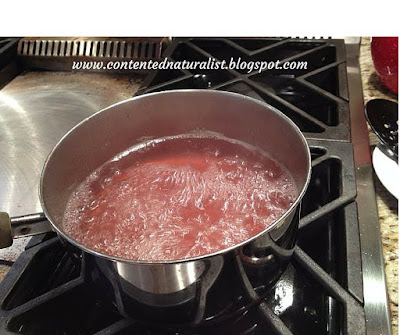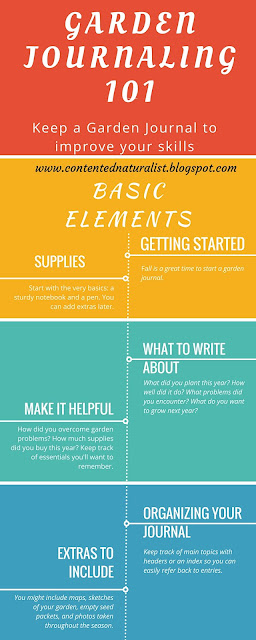I like to keep a garden journal. I note what I've planted, how it's doing, how long it took until seeds germinated and later bore fruit, and all kinds of other information. I also write about what I've been doing in the garden or what I've been thinking about the garden. It's a fun pasttime, but even more it's a great resource for me each year since I can look back on what worked and what didn't the previous year.
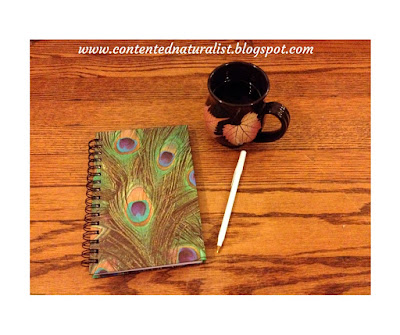 |
| To get started, all you really need are a notebook, a pen, and of course your beverage of choice. |
When should you start a garden journal?
If you've been thinking about starting your own garden journal, fall is actually a great time to start. Of course you could begin a new garden journal any time of the year, but the reflection and contemplation I feel in fall is great for getting a journal (and a garden) going. You'll muse about what worked in the garden this year, or what you hope to have in a future garden, and lots of things in between.
You can also talk to other gardening friends (and bloggers like me!) to find out what worked and didn't work for them. Was bacterial wilt a common problem in your area this summer? Did almost everybody's tomatoes take forever to start producing due to a long cold spring? These are good things to know for future planning, but also for what I like to call "CSI: garden edition." Why did my cucumber vines disintegrate in a matter of days when they should have kept producing for several more weeks? Was it something I did? Could I have prevented it?
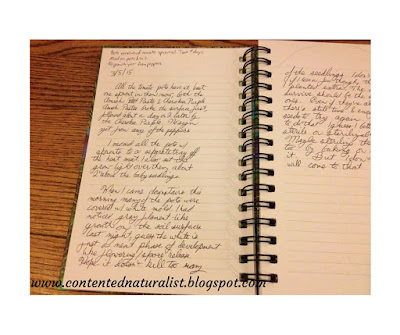 |
| I track anything that might become a problem, so I'll know when it started. |
What to include in your garden journal
But I digress. My garden journal is somewhat random. I buy a pretty blank notebook at the bookstore, and write in it whenever the mood strikes me. You can be more or less haphazard than I am, but there are a few crucial pieces of information you must include in your journal to make it a resource that will help improve your garden:
- What you planted and when.
- How well the seeds germinated, and how long it took.
- Where you purchased the seeds/seedlings, and how much they cost.
- Any special care they needed (that you did or didn't give them), e.g. you had to constantly water them during a dry spell. This will help you decide if a specific plant might be worth growing again.
- How much supplies you bought this year. Tracking how many bags/ cubic feet/etc. of mulch, compost, etc. I bought last year is really helpful for me each spring when I have to figure out what's needed, and also helps with my budgeting.
- Any difficulties you encountered over the season, and of course anything you tried to overcome them, successfully or not.
- How well each crop did-- how long until you got the first harvest, and how well you feel the plants performed over the entire summer. Did you get enough beans? Were the tomatoes really late compared to what you expected? Did one variety of peppers resist whatever wiped out the other variety?
 |
| I include sketches of my garden layout each year, to help with planning crop rotation. |
How often to write in your garden journal
Honestly, you don't have to have a specific schedule for writing in a garden journal, just whenever you have something to contribute. In the spring I tend to write frequently, then not so much in the hot summer (saving most of my energy for weeding and/or harvesting!), for example. I also like to use my garden journal in the wintertime for planning and dreaming. I brainstorm what veggies I want to grow, start thinking about what new ones I might try this year (since I like to always have an experimental crop or two), and so forth.
 |
| This was the year I let the dill take over my garden. Whoops! |
|
Extras to include in your garden journal
Other things you might like to put in your garden journal include photographs, sketches of the layout or even of individual vegetables, empty seed packets, and so forth. You could have a garden journal that's really half scrapbook, half journal, if that's what you enjoy. I don't do much scrapbooking but I do include lots of hand-drawn sketches each year of my garden layout. I like to make sure I'm rotating crops properly so I need to remember where the tomatoes have been from year to year. For that matter, I often need help remembering what kind of sprout I'm looking for in each row in the spring! I know some folks put markers in their garden, but I don't bother. Instead I just consult my map.
 |
| This year's garden map. It went through several changes between planning and planting. |
You might also like to track weather in your garden journal, especially if you can take the soil temperature. This might help later when you see that none of a certain seed germinated and you're trying to determine why-- maybe the soil was too cold or hot, or you'd had too much rain lately. You can also watch for any changes to weather averages over many years, and start to consider those when you're planning the next season. Are first frosts averaging sooner? Have several years in a row been much dryer than usual? I don't usually write frequently enough to make regular weather observations in my garden journal, but it does seem like a good idea to try.
Some gardeners like to track phenology in their garden journal, especially if they garden for wildlife instead of or in addition to growing crops for their own consumption. When did the monarch butterflies return? How late did they stick around in the fall? Did your redbud trees bloom earlier or later this year than last year? Phenology is a fun science of when events happen in nature. Don't overwhelm yourself, though-- if you're already super busy, you might find that sticking to just a few main questions is easier and more useful in your journal.
In the late winter and early spring I also use my journal to do price comparisons between different seed catalogs, so I can stick to my budget. Sometimes the same variety is in multiple catalogs but for different prices and/or different packet sizes. Other times I can compare different varieties: I can make lists of each one's touted benefits, both from the catalog description and any gardener reviews I can find online. This fall, on the other hand, I was able to jump on a last-minute seed sale that offered both free shipping and reduced-price seeds, because I knew I was unlikely to find better prices elsewhere. Yippee! I'm pretty sure the grower was offering those seeds at a discount only because they're remnants of 2015 seeds, but I also know from doing my own germination tests of four-year-old seeds that these should be fine for growing next year.
 |
| Some of my favorite seed catalogs. |
Other ways to make your journal a helpful tool
I don't know about you, but I have a really hard time remembering from one summer to the next how well something did, or exactly when I started my tomato seeds inside. Keeping a garden journal means I don't have to do the same calculations every winter, and also means I don't miss the start date because I waited too long to even think about it. For that matter, if for several years I ended up not being able to plant outside for a few weeks longer than I'd intended, but the crops grew just fine, that's great knowledge to have! So would be knowing that even a couple weeks' tardiness means the lettuce won't grow big enough before it gets too hot outside.
Organizing your garden journal
Since I use a blank book for my garden journal, I always leave room at the top of each entry to go back and write quick bullet lists of essential information. That way I can skim through previous entries to find certain information without having to read every single one. It's also essential to date each entry, by the way. I tried making my own index at the back of a journal one year, so I could quickly look up when I wrote about the peas sprouting, for example. The problem with the back index was that I quickly ran out of space. Maybe next time I start a new volume I'll make an index for just keywords and page numbers (or dates), so all the times I wrote about the peas can be grouped together, as will all the times I wrote about any seed sprouting. That might work better.
If you enjoy using "to-do" lists, your garden journal would be a great place to copy your lists of garden tasks each day/week/month/season. This could be a helpful reminder from year to year what's been done and what still needs to be done. If you're anything like me and often don't get to the bottom of a to-do list, it can also help you remember the following day/week/whatever that you should add that back to your list. Most of my daily to-do lists are made on the back of scrap paper or junk mail envelopes, which makes it easy to carry around with me during the day but also makes it easy to misplace.
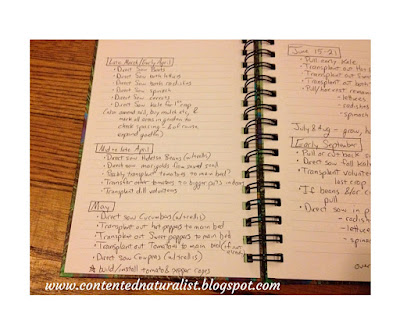 |
| This year I made a set of to-do lists so I wouldn't forget anything. It really helped, even when I missed my goal date by a few weeks. |
Essentials to remember for garden journaling
- Writing in your garden journal should be enjoyable. Remember to write about triumphs as well as failures!
- Your garden journal will be potentially useful as a whole, but each individual entry doesn't need to seem useful at first. Just write about what's been happening in the garden when you feel like it.
- Reread your previous entries each year (or more often) to see how you might grow as a gardener. Maybe after the pain has subsided from all your tomatoes dying prematurely, you'll be able to see what you could have done better.
- Let your garden journal grow with you-- you can add or omit sections from year to year as needed. Keep reading about garden techniques and try new things. Talk to other gardeners too, whether online or in your own neighborhood. Soon I'll post some ideas for helpful resources for both planning and evaluating your garden, so stay tuned for that.
Do you keep a garden journal? What are the most useful aspects of a journal for your garden? Let me know in the comments if I missed anything you find essential.



